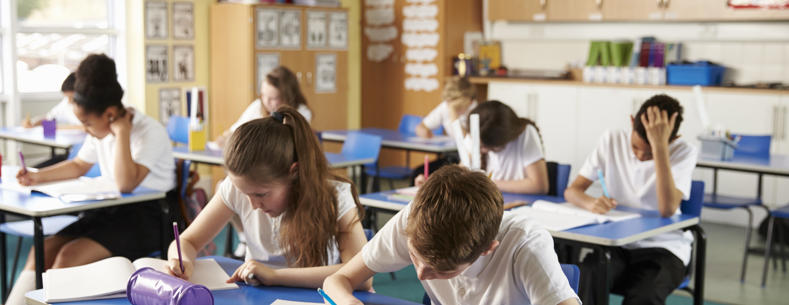This is the sixth article of our ten-part series looking at the Welsh Government’s progress in delivering its Programme for Government (PfG). Here we explore the well-being objective to “Continue our long-term programme of education reform, and ensure educational inequalities narrow and standards rise”.
There are 10 specific commitments beneath this broad Cabinet-wide objective, which the Welsh Government has given an update on in its PfG annual report. There are also relevant Ministerial commitments.
Browse our full #ProgrammeforGovernment series, published to date.
The COVID-19 pandemic disrupted an education sector already tasked with implementing substantial reforms. In addition to these challenges, the Welsh Government seeks to maintain its long-standing focus on raising standards and closing attainment gaps.
Raising school standards
The Welsh Government has had a 'national mission' to improve education standards for well over a decade, ever since the “wake up call to a complacent system” following the 2009 Programme for International Student Assessment (PISA) results.
This ‘national mission’ was hit by the pandemic. The Minister for Education and Welsh Language, Jeremy Miles MS, published a new school improvement framework in summer 2022, and a ‘roadmap’ in March 2023 giving an updated overview of the Welsh Government’s education priorities .
Self-evaluation is now the starting point of a school’s improvement activity, with the regional consortia (whose role is currently under review) being key players. Education inspectorate, Estyn, has changed its approach to inspection and no longer issues headline gradings, instead focusing on a school’s strengths and areas for development.
In 2018/19, the final year when Estyn used headline gradings and before inspections were suspended due to the pandemic, four (14%) of the 29 secondary schools inspected had ‘unsatisfactory’ standards, while a further 12 (41%) were only ‘adequate’.
Estyn continues to identify schools causing concern. Figures requested by Senedd Research show 22 primary schools (2% of total), 10 secondary schools (6%) and one all-age school (4%) are currently in a statutory category. This means they either require ‘significant improvement’ or are under ‘special measures’.
Whilst PISA results don’t tell us everything, the 2022 cycle will shed further light on progress when results are published this December. Wales’ PISA scores improved slightly last time in 2018 but remained the lowest of the UK nations. The Minister indicated in October 2022 that the Welsh Government has dropped a previous target of 500 points in each of the Reading, Mathematics and Science domains.
The context of the pandemic
One Programme for Government (PfG) commitment is to “fund up to 1,800 additional tutoring staff in our schools” through the “Recruit, Recover and Raise Standards” (RRRS) response to the pandemic’s disruption to education.
The Welsh Government is spending £37m in 2023-24 and £29m in 2024-25 to continue RRRS, following £166m already spent since 2020-21. The Education Policy Institute reported in 2021 that Wales had the highest COVID education recovery spend in the UK at £400 per pupil.
An independent evaluation estimates that 2,452 Full Time Equivalent (FTE) staff in schools have been funded by RRRS. 62% of these are support staff and 30% are teachers. It also found the most common interventions delivered to learners in schools have focused on literacy (in 91% of schools) and well-being (in 86% of schools).
Pupil attendance is yet to return to pre-pandemic levels, particularly among deprived pupils. The Minister has responded, including communicating to families the importance of attending school.
In addition to the latest public health advice to schools regarding COVID (last updated in June 2022), the Welsh Government has also issued guidance on learning continuity during periods of disruption to schooling. Overall, Estyn reported in January, schools have “coped well” but things aren’t “back to normal” yet. The Minister has committed to giving the Senedd’s Children, Young People and Education (CYPE) Committee six-monthly updates on children and young people’s recovery from the pandemic.
Implementing major reforms
A new Curriculum for Wales has been introduced in primary schools and is now being rolled out in secondary schools by year group.
Considerable stock is being placed on the new curriculum to improve standards, through the greater freedom it gives to schools to teach ‘what matters’. However, some stakeholders (such as education training provider, ‘Impact School Improvement’, and the University of Wales, Trinity Saint David) have warned that it may worsen standards and exacerbate, rather than narrow, inequalities. The Committee which scrutinised the legislation in 2020 warned that, whilst the Curriculum for Wales may not be uniform across all schools, it must be sufficiently consistent so pupils get equal opportunities and experiences.
The Welsh Government is publishing annual reports on curriculum implementation with this summer’s version reporting “very positive progress”.
Schools are also tasked with delivering a new Additional Learning Needs (ALN) system, replacing a Special Educational Needs (SEN) one described as “no longer fit for purpose”. However, this is proving no mean feat due to the numbers of pupils involved and the Welsh Government has had to delay implementation.
There has also been a shift towards universal provision for learners previously identified with low levels of SEN, meaning they are not recognised as having ALN and do not receive an Individual Development Plan (IDP). This is despite the Welsh Government saying during the passage of the legislation that the cohort covered would remain broadly the same and projecting a number of IDPs equivalent to the then total SEN cohort.
The Minister says “the landscape has changed quite a lot” since the ALN reforms were first conceived, pointing to the more inclusive approach of the Curriculum for Wales. However, the CYPE Committee has highlighted falling ALN numbers in its scrutiny of education reforms.
The Welsh Government is also transforming the funding, governance and regulation of post-16 education, training and research. The Tertiary Education and Research (Wales) Act 2022 dissolves the Higher Education Funding Council for Wales (HEFCW) and establishes the Commission for Tertiary Education and Research (CTER).
CTER will be responsible for funding, overseeing and regulating tertiary education and research which comprises higher education, further education, apprenticeships, sixth forms and adult community learning. Our recent article explains more about the next phase of CTER’s establishment.
CTER will also be responsible for implementing the Welsh Government’s Innovation Strategy, another PfG commitment. The Strategy is a cross-government vision with four specific missions: education, the economy, health and well-being, and climate and nature. It says the Government will publish an action plan which will include “a limited amount of specific and measurable mission goals”. The Minister for Economy said in June the Government is “looking to publish [the action plan] over this autumn”.
Inequalities and attainment gaps have widened
The Minister for Education and Welsh Language has vowed to prioritise “high standards and aspirations for all” and pursue all education policies through a lens of tackling the negative impact of poverty on educational attainment. The Welsh Government continues to spend over £130m each year on the Pupil Development Grant (PDG), which supplements schools’ incomes based on their numbers of pupils eligible for free school meals (eFSM).
Before the pandemic, Estyn reported that the ‘poverty gap’ between eFSM pupils’ and non eFSM pupils’ attainment had not narrowed over the previous decade and typically widens as pupils become older. Estyn has since reported (in both 2022 and 2023) that the pandemic has exacerbated attainment gaps and disproportionately affected pupils from deprived backgrounds.
Research by the Education Policy Institute (EPI) found a wider disadvantage gap in Wales than in England, with both nations only making modest progress during the last decade. In Wales, GCSE attainment gaps between eFSM pupils and their peers widened between 2015/16 and 2021/22:
- from 15 to 19 percentage points at grades A*-A;
- from 25 to 28 percentage points at grades A*-C; and
- from 3 to 6 percentage points at grades A*-G.
There was also a widening between 2015/16 and just prior to the pandemic (2018/19) at all grade intervals, and between 2018/19 and 2021/22 at grades A*-A and A*-G. Attainment data by FSM status is not yet available for the 2023 results.
The Welsh Government has also committed to increasing opportunities for learners from disadvantaged backgrounds to take part in the Seren Network. This is “dedicated to helping Wales’ brightest state educated learners achieve their full academic potential and support their education pathway into leading universities”.
The Minister told the Senedd in March 2022 that Seren’s focus would shift to “increasing involvement in the network of learners from low-income households”. It’s not clear how the Government intends to target these learners or what progress it has made so far.
The Minister has also said the Government is “looking at what we can do so that Seren can encourage the brightest learners to take vocational options at higher levels as well”.
Prospects for success
The publication of the PISA results this December will give one indication of whether the Welsh Government is on track to raise standards. There also needs to be more progress than in the past decade on narrowing attainment gaps if a real dent is to be made on reducing educational inequalities this Senedd. Emerging from the shadow of the pandemic and the success or otherwise of major education reforms will also be key determinants of Welsh children and young people’s long-term prospects.
Explore the Programme for Government, its objectives and commitments
- 1. Provide effective, high quality and sustainable healthcare
- 2. Protect, re-build and develop our services for vulnerable people
- 3. Build an economy based on the principles of fair work, sustainability and the industries and services of the future
- 4. Build a stronger, greener economy as we make maximum progress towards decarbonisation
- 5. Embed our response to the climate and nature emergency in everything we do
- 6. Continue our long-term programme of education reform, and ensure educational inequalities narrow and standards rise
- 7. Celebrate diversity and move to eliminate inequality in all of its forms
- 8. Push forward towards a million Welsh speakers, and enable our tourism, sports and arts industries to thrive
- 9. Make our cities, towns and villages even better places in which to live and work
- 10. Lead Wales in a national civic conversation about our constitutional future, and give our country the strongest possible presence on the world stage
Article by Michael Dauncey and Lucy Morgan, Senedd Research, Welsh Parliament






